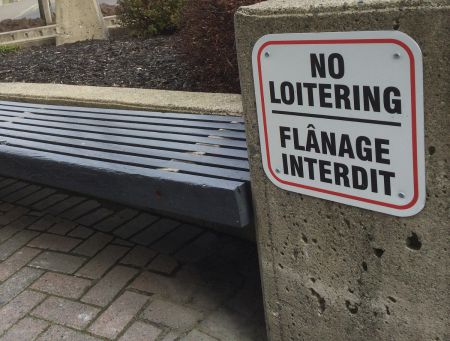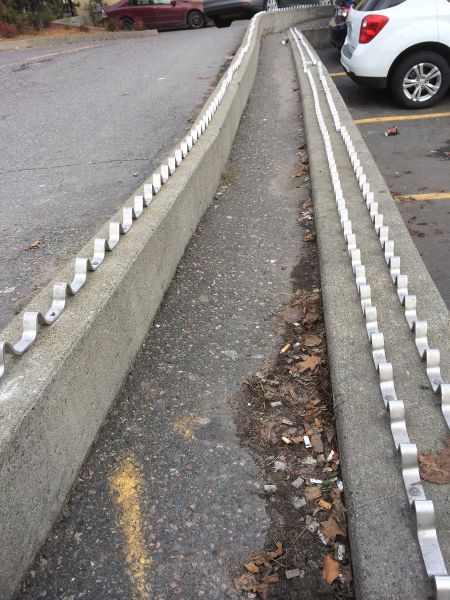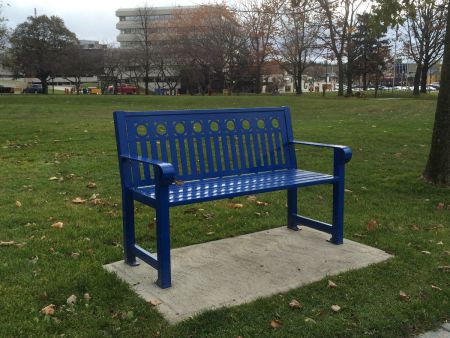Many studies, speeches, and proposals in recent years have made suggestions about the "what" and "how" of transforming the downtown in Sudbury, Ontario. Much less attention has been paid, however, to the "who." Among the many different groups of people who live, work, or otherwise spend time in the city's core, who will benefit from the trajectory of change sought by those who champion revitalization, and who might pay the price?
Members of the Sudbury Coalition Against Poverty (S-CAP) say that changes made in the name of revitalization have already had a negative impact on people living in poverty. And academic studies both of urban renewal in general and of the changes happening specifically in Sudbury confirm that this is a grave concern.
Phil Marsh and Clarissa Lassaline are organizers with S-CAP. Based on what they've heard over the last few years from people living in poverty in the downtown, there seem to be three main ways that the downtown is becoming less welcoming: It is becoming harder to find an affordable place to live; public spaces are being changed; and experiences with law enforcement are making it less welcoming.
Housing
Lassaline said that increasing numbers of people that S-CAP works with are reporting to them that "the only place where you can find accommodation now is out and away, out in the outskirts" of the city.
The precise factors underlying this shift are unclear. According to research published by the City of Greater Sudbury at the end of 2013, circumstances have become increasingly grim for low-income renters throughout the region. In the Greater Sudbury area between 1996 and 2011, average market rents increased by almost 50% (17). Average market rent for a bachelor apartment in 2012 was $575, and for a one-bedroom apartment was $737 (17), yet the shelter allowance for a single individual on OntarioWorks is $376 per month, and for people on Ontario Disability it is $479 (8).
The distribution of affordability across the municipality is not known, and few published statistics seem to address the downtown specifically, but there is evidence of changes in amount and geographical distribution of housing. Between 2006 and 2011, the number of households in Greater Sudbury as a whole increased by 4.1%, but the number in Sudbury proper decreased by 3.5% (3). Moreover, between 1996 and 2011, there was a loss of almost 2000 rental units in the city (13).
Marsh wasn't sure how many of those lost units were from the downtown, but he does know that "some buildings where people have lived in cheaper rental units are not here any more." A clear example was the demolition of a single-room occupancy building on Pine Street, near the N'Swakamok Native Friendship Centre, in the summer of 2014. Marsh said, "So that housed thirty people. Now where are those thirty people? It looks like they're displaced."
Marsh was very clear that many poor downtown residents experience major negative impacts when displaced to other parts of town. Getting around the city can be very difficult for people with little or no money, and regardless of where people end up living, many services related to poverty, migration, the specific needs of indigenous people, employment, social assistance, and mental health are still located downtown. "They depend on these services to live," Marsh said. For people living in poverty, "even the Donovan is far for them, especially in inclement weather. It's a challenge for them to get here." He knows of people who were displaced from downtown to the Donovan who "can only eat once a day because they can only get to The Mission once a day."
Changing Space
Recent years have also seen many changes in the space downtown. Marsh argued that these changes are largely not beneficial to people living in poverty who have lived in the neighbourhood for years, while some are actively harmful to them.
As an example of the former category, he pointed towards the new Laurentian University School of Architecture as a major development that may bring new people into the neighbourhood but that "is not really doing anything for people who have lived here. ... What's going up is not something that they'll ever use."
He also noted that poor downtown residents he has worked with have grumbled about the many patios that appeared for the first time over the summer of 2014. People have complained about them "partially blocking the sidewalk," particularly given that they "would never be able to afford to eat or have a drink at those places."
Other changes, though, are clearly deliberate attempts to shift how people living in poverty use the downtown. Marsh pointed to the metal spikes placed on potential sitting surfaces on Cedar Street next to Tim Horton's and the municipal transit terminal. "That doesn't impact any consumers who are just walking by," Marsh said. "They're downtown for an hour. But for people who live here ... and want to use the space downtown, these are barriers."
Downtown Research
As part of her graduate studies in the Interdisciplinary Humanities MA program at Laurentian University, Elizabeth Aho did research on the "physical, symbolic, and imaginary geographies in downtown Sudbury and relat[ed] them to issues of difference."
Despite lots of talk affirming "diversity" in documents produced by the municipality and by the Downtown Business Improvement Area (BIA), she found that actual interventions in the space to translate these visions into reality reinforced "so many levels of pathologizing that space and pathologizing [poor] people." Through physical measures meant to shape the use of particular public spaces, people living in poverty get framed as undesirable, or even "dangerous" and "scary," and by being in those spaces they are marked as "deviant."
For her as well, the space on Cedar Street by the bus station was an important example. She was powerfully struck by an image she saw in which a number of people were hanging out there, in this space "where there are these garbage bins and lots of spikes or jagged metal pieces deterring people from sitting on ledges that are right near a dumpster, and there are 'no loitering' signs and this black fence and stuff." She said that the take-away message is clearly "Don't be here!" and it is "pathologizing" for those who are there.
She found other examples as well -- "many 'no loitering' signs" throughout the downtown, for instance. She also noted that "the park benches in Memorial Park, the new ones that they put in, have arm rests and they are shorter in length, basically deterring people from lying down on them. That's often why those kinds of benches are placed in parks." As well, she said, "the planters along Durham Street are meant for people to sit and congregate ... but some business owners find that they should be putting fencing along these planters too to deter panhandling and these kinds of activities."
All of these things add up to powerful messages about who is welcome and who is not, and whose ways of using downtown space are permitted and whose are not. Basically, she said, "it seems like people are discouraged from spending time downtown unless they are spending money."
She sees a similar phenomenon in the ways discussions of panhandling happen in the city. She noted, "Panhandling isn't illegal, but they like to throw the phrase 'aggressive panhandling' around to blanket all panhandlers as being, you know, aggressive people who are a threatening presence in downtown Sudbury. ... Again, that comes back to the whole pathologizing ... lower income individuals"
Law Enforcement
Another pattern of experience that the S-CAP organizers say they hear about commonly from people living in poverty in the downtown is treatment by police and by-law officers that makes public space in the downtown less welcoming and safe for them.
City staff pointed out that there is no by-law related to panhandling, so by-law enforcement officers take no role in responding to it, and only issue tickets when a by-law has been breached.
Staff Sergeant Richard Waugh of the Greater Sudbury Police Service (GSPS) said that in his experience, police response to panhandling -- when it isn't one of the rare instances that shade into criminal behaviour of some sort -- is mostly "complaint driven," mostly focused on "safety," and in fact not particularly centered on the downtown. The majority of calls they get to respond to panhandling involve people who are doing so in the centre traffic island at an intersection, which he identifies as a safety concern, and that happens in all parts of the city. "We always respect people's civil rights," he continued. "People ask for money for all kinds of reasons ... [and] I respect that."
Nonetheless, there is some evidence of broader attention by the GSPS to deterring panhandling in general, with specific focus on shaping downtown space in particular directions. A consultant's report evaluating the impact of closed circuit TV (CCTV) surveillance in the downtown published 14 years ago and still available on the police website includes evaluation of CCTV's impact on panhandling, which it labels as "anti-social" (1) and "non-criminal" (4), but still as something that the police have an interest in being able to "deal with" (1). The reason behind an interest in addressing what is identified as "anti-social behaviour" is described in the report as "increasing the sense of security for residents and businesses in the area" (15).
As well, in 2012 there was a high-profile controversy after the GSPS collaborated with the Downtown BIA to produce posters that encouraged people downtown not to engage with or give money to panhandlers, and to call the police if they "feel threatened." The posters were withdrawn after a community outcry, including by S-CAP.
Marsh said it isn't always easy to get a sense in casual conversation with people living in poverty in the downtown when such incidents occurred, or whether it was with police or by-law officers. Nonetheless, many people he works with report getting arbitrary tickets for minor infractions related to things like jaywalking, littering, smoking, and panhandling. And he knows it isn't a thing of the past: "I still hear anecdotes -- people downtown being charged for panhandling. ... It's still ongoing."
He sees this as fitting into the same pattern as the changes in the physical space, in that "if you're not a consumer in this downtown, you don't belong."
Gentrification
Ted Rutland is an Assistant Professor in the Department of Geography, Planning, and Environment at Concordia University in Montreal, and his research focuses on the role of race and racism in urban planning in Canada and around the world. For many years, scholars and activists have recognized a process called "gentrification," which Rutland defines as "the class process, usually at the neighbourhood scale, whereby a working-class population is replaced by ... a higher-income group of people." It is a process that is often racialized -- and, indeed, given the prevalence of indigenous people in Sudbury's downtown and among people living in poverty in the city, both Lassaline and Aho agreed that it probably is to a certain extent here as well, though neither was able to say much about how the racialized dynamics play out locally.
Rutland said there are two general kinds of objections to gentrification. One focuses on the oppressive character of "displacement" via residential changes -- evictions, loss of housing, rent increases -- and "different kinds of policing practices, different kinds of retail establishments in neighbourhoods, all kinds of things that make people feel less at home, more vulnerable, in their neighbourhoods."
He also said it is worth being critical of more ostensibly voluntary aspects, where it's a matter of low-income people leaving a neighbourhood without being pushed, because "even when it's just a kind of succession or voluntary change, you're talking about more privileged people taking over the spaces in the city that they want and forcing everybody else to live in the spaces that they don't want."
Gentrification in many cities started in a major way in the 1960s and 1970s, as major institutional investors realized that "there was more money to be made in the remaking of working-class neighbourhoods than in certain other things they could invest in."
Rutland sees this imperative to profit as the biggest driver of gentrification in many instances, but he also sees cultural factors driving it. In the social movements of the 1960s and 1970s, there was often a tenuous alignment of more explicitly political and radical movements with movements having a more cultural, aesthetic, or lifestyle focus. He argued, "Since then, a lot of the more radical movements have been repressed out of existence through policing, through changing geopolitical orders around the world, through the prison-industrial complex, and what has remained is a kind of artistic or aesthetic critique. Many people who are espousing it believe it is still radical, but it is not radical any more." This stance has been "totally absorbed by capitalism itself and [is] part of what's driving capitalist growth" and "those movements have usually become detached from concerns about social justice, about working-class people, about racialized people, about indigenous people." People who identify with such a stance often drive gentrification because they see their "anti-suburban" position as being inherently "anti-conformist or progressive. And it can be. But most of the time it isn't."
As well, he said that all levels of government currently act to support gentrification -- the federal government via the ways in which the Canada Mortgage and Housing Corporation ensures that certain kinds of mortgages are readily available to middle-class households; the provincial government through landlord/tenant rules that facilitate displacement; and municipalities through a variety of kinds of decisions about land use, driven by the fact that gentrification leads to higher property values, and higher property values lead to greater income for cities via property taxes.
He said that most research on the phenomenon has been done in larger cities, where capital seems particularly important in driving it. In smaller cities, while gentrification is often happening, large investors seeking a profit seem to play less of a role.
Based on his own research in Halifax as well as anecdotal accounts from other small cities, "A lot of what you see is young people, sometimes young families, buying up semi-run down houses in working-class neighbourhoods, and fixing them up themselves. Which happens in big cities too, but ... it is almost entirely that in smaller places." He said that many such household-level practices, as well as government-level policies that enable them, make things a little easier for middle-income families feeling the squeeze of increasingly difficult times, but do so in ways that end up being detrimental to poorer households -- in part by becoming "a driver for gentrification."
Rutland concluded, "The way that politicians talk about the 'poor middle-class' is that they only want to talk about the middle-class, and they mostly want to help them by pursuing policies that are detrimental to working-class people." In contrast, he said, "You could certainly imagine a politics that made things easier for middle-income people while also making things better for working-class people."
Scott Neigh is a writer, activist, and media producer based in Sudbury, Ontario. He is the host of Talking Radical Radio, the author of two books of Canadian history told through the stories of activists, and a blogger.




